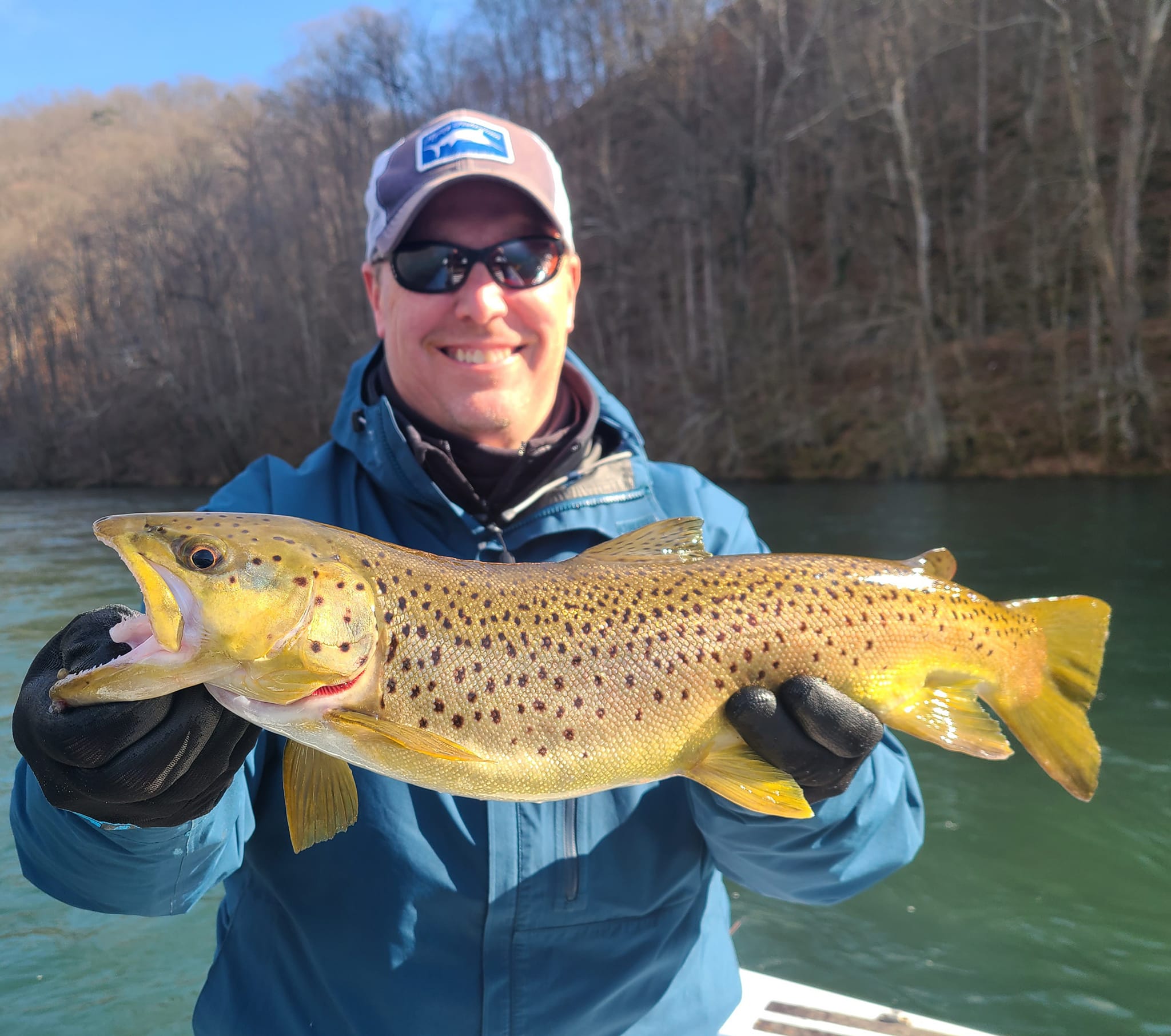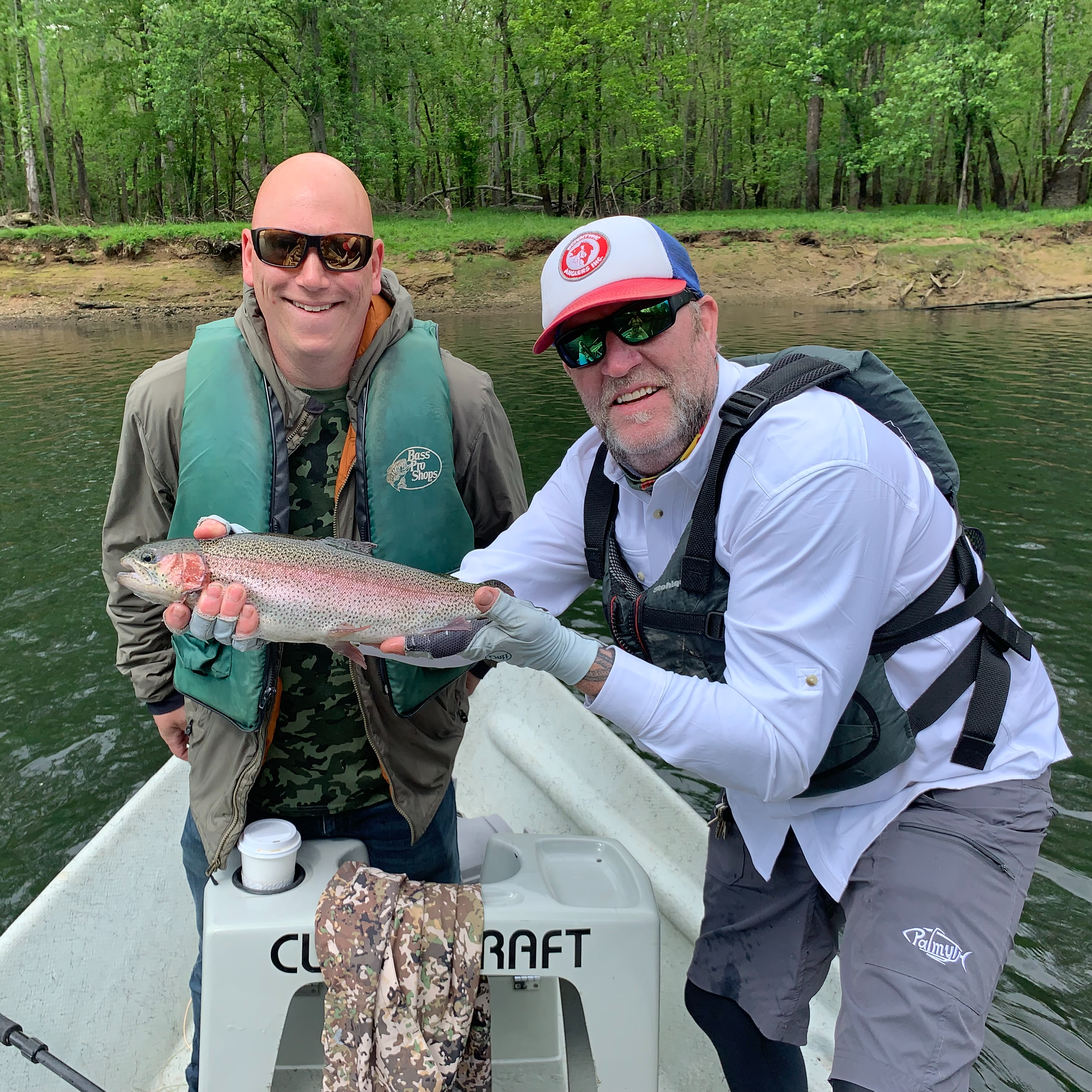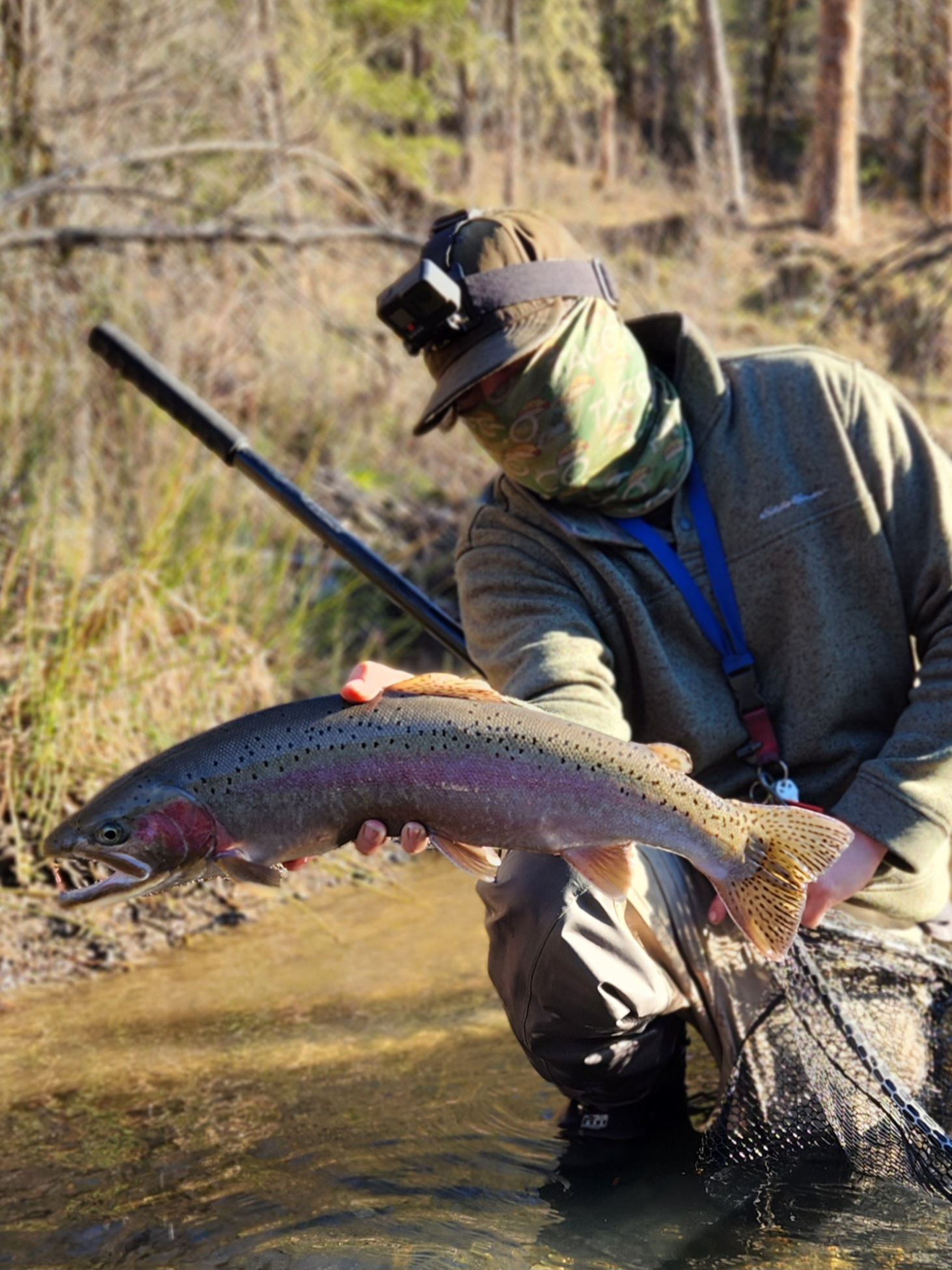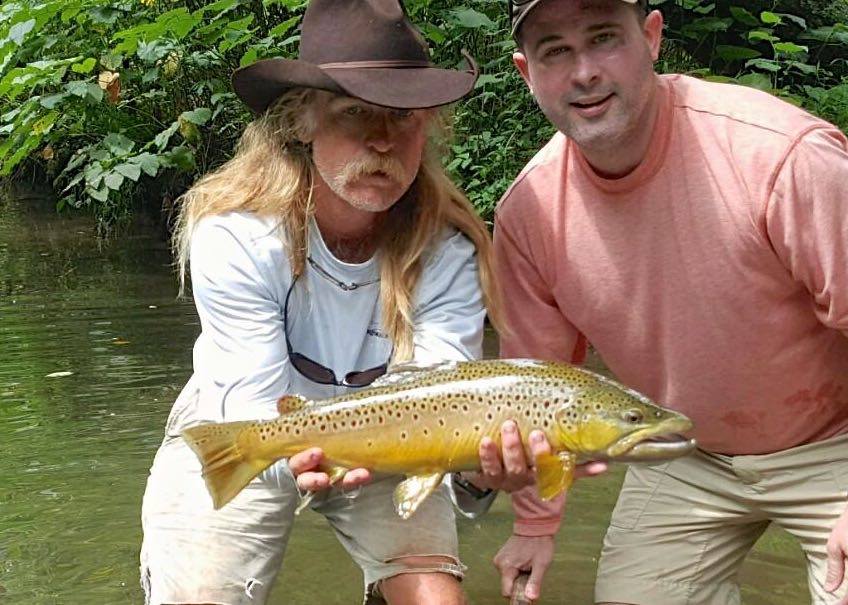Damn Good Guides
Experts Available 24/7
100% Weather Guarantee
Top Cities for Rainbow Trout Fishing
“Our Damn Good Guides go above and beyond, and we’ve handpicked every single one. We’re passionate about the outdoors and look forward to getting you out on the trip of a lifetime, every time.”
Jonathan and Attison | Co-founders | Austin, Texas
Rainbow Trout Fishing Guides
River Fishing Salmon Or Steelhead
Yellowstone River Full-Day Jet Boat
Elk Rapids Ice Fishing Adventure
Float Fishing Trip
Olympic Peninsula Steelhead
8 Hour Trip – Fall Kings
Everything to Know About Booking a fishing trip
What are the best rainbow trout fishing trips?
The best rainbow trout fishing trips are:
What is a Rainbow Trout?
Arguably the most iconic freshwater species to catch on the fly in North America, the rainbow trout (Oncorhynchus mykiss) is a salmonid native to cold-waters feeding into the Pacific Ocean on both the Western side of North America and the Eastern part of Asia, although the species has been introduced worldwide. It is actually one of the top invasive species around the world, mostly due to the breadth through which the fish has been manually spread, but they can also have a big impact on native species mostly through out-competing them. Rainbow trout have been transported around the world mainly for sport, and are now found on every continent except Antarctica, in many places providing a great gamefish opportunity where previously there was little.
Steelhead (steelhead trout) are a distinct anadromous form of coastal rainbow trout, meaning they live in saltwater but return up freshwater tributaries to spawn after a few years. Steelhead are the state fish of Washington, and are much more threatened than rainbow trout due to a much lower distribution and greater changes to their native habitat. While rainbow trout have been introduced into streams all over the world, steelhead rely on clear waterways in the Pacific Northwest to spawn.
Steelhead have also been introduced and do well in the Great Lakes area, spawning upstream from the lakes and erstwhile living in the lakes.
Adult rainbow trout can vary in color depending on habitat and location (and steelhead trout vary even more), but they are generally distinguished by a broad red stripe along their lateral line that is most prominent along the line and fades as it expands out. They can often appear greenish/silver above and below the lateral line.
Rainbow trout are probably the most common trout globally and therefore the most commonly caught, and they are a many a beginner’s introduction to fishing in streams around the world, particularly those fishing on the fly. They can be somewhat picky with presentation and skittish in general, which makes them all the more of a treat and a challenge. Aside from bass & panfish they are the most common freshwater fish sought in the US.
How big do Rainbow Trout get?
Rainbow trout size is an interesting question, because a “good” sized rainbow trout depends entirely on where you are and how big the waterway is. Fishing the streams of the Appalachians you’ll be happy with a 1/2 pound fish but head to Alaska and you’ll expect 10 pounders.
Generally most rainbow trout are between a half pound and 5 pounds, and lake-dwelling or anadromous fish can get to 20 pounds or more, behaving and appearing much more like a salmon than a trout from a small stream.
What's the biggest Rainbow Trout ever caught?
The world record rainbow trout belongs to Canadian Sean Konrad (who has been sharing titles back and forth with his brother). The fish is an absolute monster at 48 pounds and 42 inches, and was caught in Lake Diefenbaker, Saskatchewan, Canada. There is some controversy here though, as many have pointed out that there was a fish farm nearby that held triploid trout which may have escaped, and which some believe are clearly causing these massive fish.
Put simply, a triploid trout is one with an extra set of chromosomes. This renders the fish infertile, and the resources the fish would have spent on reproduction instead move towards growth and girth. This is great for fish farms that aim to provide the biggest fillets, but not for allowing a fair record fight.
That record was caught on a spinning rod, but the record on a fly is still a whopping 30 pounds 15 ounces, caught by Dietmar Jeschke on the Ruhr River in Kreuzau, Germany on 12 lb line.
Where is the best place to catch Rainbow Trout?
Honestly - everywhere. This is one of the widest-ranging fish in the world. From small mountain streams to giant lakes to even some anadromous fish, you really won’t struggle to find rainbow trout.
The species is native inland up to British Columbia and Alberta, and in the Pacific Northwest in Washington, Oregon, Idaho, Montana, and arguably Nevada. Steelhead occupy much of the same area on the coast, plus across the Pacific into Kamchatka and the Aleutian Islands in Alaska. The species has been introduced to much of the rest of the US, Canada, and the world.
While you can catch fish in many places, there are many reasons to want to catch native trout (more meaningful for one, but the fish also fight better on the line and generally speaking present more of a challenge to the angler). For the same reasons, it is preferable to fish where the trout are spawning on their own, rather than being stocked year over year, which expands your areas of opportunity quite a bit, as rainbow trout can and do sustain natural populations in many places around the world.
Rainbow trout tend to live in cold water, generally fast-moving rivers and streams with gravel beds, and generally freshwater (aside from steelhead).
Alaska has some of the largest rainbow trout in the wild (excluding large stocked fish some locations release). Head to the Kvichak or Naknek rivers. You can also head over to Kamchatka which is rumored to have some huge wild rainbows (along with some other monsters - see siberian taimen).
When should I catch Rainbow Trout?
The best time to catch rainbow trout will depend on the time of year, time of day, location, and importantly the water temperature. They can be fished year-round, but late spring is generally considered best, when waters are still cold and water levels have not receded in the summer yet.
Later in the season in the heat, trout also are more sensitive to pressure and if the water is too hot they will often not recover from the fight and being handled, so it is best to be mindful of the water temperatures when fishing catch and release.
Steelhead can be caught as they move upstream for their annual spawning runs, but when this occurs depends a lot on where you are. Steelhead can spawn in winter or summer and, appropriately, their runs will be called either the summer-run or the winter-run. Some waterways hold both, one, or neither, so it is best to let your guide or some quality research help you determine what would be best.
How do you catch Rainbow Trout?
Trout fishing is partially satisfying purely because of the effort it can sometimes take to get to quality fishing spots, and some liken trout fishing more to hunting and tracking due to the active nature of the hiking and searching for fish, especially since many streams and rivers are not accessible by boat.
Rainbows are also fun to catch - they often put up a good fight for a smaller fish and will jump when hooked. Since many anglers are using smaller tackle, these fights are even more challenging and enjoyable.
Fishing for rainbow trout can be done on conventional tackle or on the fly, with many anglers preferring the challenge of using a low-weight fly rod with light line for added challenge (not to mention the challenge involved in not hooking one of the many trees that are guaranteed to overhang many trout streams).
Catching steelhead will generally take somewhat bigger tackle. To catch steelhead with conventional gear, consider spinners with spoons as a good option, as well as plugs and jigs in the 1-3 inch range. Trout can be finicky, so sometimes one lure will turn off just as another turns on, so it’s good to be able to mix it up.
To catch trout on the fly, anglers usually try to match the hatch, meaning they pick flies that mimic not only native insect species or other food options in the area, but also will match insects that are breeding at that particular time of the year. Rainbow trout will often be seen eating the current hatch and nothing else that is presented. Rainbows also typically hunt beneath the surface so while some anglers might use dry flies, something that sinks is a little better, like a nymph or small streamer.
Make sure you cast well - sometimes a poor cast can spook the fish and ruin a spot for your afternoon. Your retrieve can be slow to match that of a floating, injured insect, and you can experience the true pleasure of watching a rainbow slurp your fly (and hope they don’t spit it right back out - set the hook quickly).
Are Rainbow Trout good to eat? What are the best Rainbow Trout recipes?
Cooking and eating rainbow trout is a true treat. Wild-caught rainbow trout taste absolutely incredible no matter who you talk to, having a tender, pink flesh and a mild flavor, often compared to a milder (and smaller) salmon.
Rainbow trout are also frequently farm-raised, although fish raised on pellets will not taste nearly as good as something wild. True aficionados can even tell the difference between a wild-caught stocked fish and one that was actually born in the wild. A true wild fish will have more depth of flavor and a slightly gamier taste (in a good way).
In some locations (like Montana) it is illegal to sell wild-caught rainbow trout, so in the fish market you will find farmed fish, which are known as one of the best farmed fish options out there.
Trout don’t need to be scaled or skinned to be eaten, and it is often preferable to cook them skin-on to hold the meat together. Sometimes the fish are not even filleted, although you’ll still want to debone. The fish are (according to us) best baked with some lemon and butter.
Recent Reviews
Cities
- Albuquerque, NM
- Arusha, Tanzania
- Austin, TX
- Avon Lake, OH
- Batesville, AR
- Bend, OR
- Beulah, MI
- Bishop, CA
- Blacksburg, VA
- Blue Ridge, GA
- Boone, NC
- Bozeman, MT
- Branson, MO
- Bristol, TN
- Broken Bow, OK
- Buffalo Valley, TN
- Cherokee, NC
- Clarkesville, GA
- Cody, WY
- Cottage Grove, OR
- Cotter, AR
- Crow Agency, MT
- Diablo, WA
- Eagle Nest, NM
- Elk Rapids, MI
- Ellensburg, WA
- Elma, WA
- Emigrant, MT
- Ennis, MT
- Eureka Springs, AR
- Fairport Harbor, OH
- Flippin, AR
- Florence, OR
- Fort Smith, MT
- Gallatin Gateway, MT
- Gold Beach, OR
- Goldendale, WA
- Graford, TX
- Granbury, TX
- Grand Haven, MI
- Heber Springs, AR
- Helena, MT
- Highlands, NC
- Hume, CA
- Indiana, PA
- Jackson, WY
- Johnson City, TN
- Kenosha, WI
- Ketchum, ID
- King Salmon, AK
- Knoxville, TN
- Lake Stevens, WA
- Leaburg, OR
- Leicester, NC
- Lewiston, CA
- Lewiston, NY
- Livingston, MT
- Ludington, MI
- Mastic, NY
- Mattawa, WA
- Milwaukee, WI
- Missoula, MT
- Montesano, WA
- Moses Lake, WA
- Mountain Home, AR
- Navajo Dam, NM
- New Braunfels, TX
- Newaygo, MI
- Norfork, AR
- Oswego, NY
- Portland, OR
- Provo, UT
- Pulaski, NY
- Raton, NM
- Rockbridge Baths, VA
- Rogers, AR
- Roswell, GA
- Saint Xavier, MT
- Salem, OR
- Salem, SC
- Sargents, CO
- Sheboygan, WI
- Sheridan, MT
- Silver Star, MT
- Springfield, OR
- Stanwood, MI
- Steamboat Springs, CO
- Stockton, CA
- Strasburg, VA
- Table Rock, MO
- Talkeetna, AK
- Twin Bridges, MT
- Watauga, TN
- Whitby, Canada
- Whitehall, MI
- Yellowstone National Park, WY
Other Fishing Species
- Arctic Char
- Atlantic Mackerel
- Atlantic Salmon
- Black Seabass
- Bluefish
- Bluegill
- Bonito
- Bowfin
- Brook Trout
- Brown Trout
- Bull Trout
- Burbot
- Calico Bass
- Carp
- Channel Catfish
- Chinook Salmon
- Chum Salmon
- Coho Salmon
- Crappie
- Cutthroat Trout
- Dolly Varden
- False Albacore
- Flathead Catfish
- Flounder
- Fluke
- Freshwater Drum
- Garfish
- Golden Trout
- Guadalupe Bass
- Hybrid Striped Bass
- Lake Trout
- Lake Whitefish
- Largemouth Bass
- Muskie
- Northern Pike
- Paddlefish
- Perch
- Pink Salmon
- Rio Grande Cutthroat Trout
- Scup
- Smallmouth Bass
- Smallmouth Buffalo
- Sockeye Salmon
- Spiny Dogfish
- Spotted Bass
- Steelhead
- Striped Bass
- Sturgeon
- Tautog
- Triggerfish
- Walleye
- Weakfish
- White Bass
Featured Cities
- Fishing Charters Near Me
- Austin Fishing Guides
- Biloxi Fishing Charters
- Bradenton Fishing Charters
- Cabo San Lucas Fishing Charters
- Cancun Fishing Charters
- Cape Coral Fishing Charters
- Charleston Fishing Charters
- Clearwater Fishing Charters
- Corpus Christi Fishing Charters
- Crystal River Fishing Charters
- Dauphin Island Fishing Charters
- Daytona Beach Fishing Charters
- Destin Fishing Charters
- Fort Lauderdale Fishing Charters
- Fort Myers Fishing Charters
- Fort Walton Beach Fishing Charters
- Galveston Fishing Charters
- Gulf Shores Fishing Charters
- Hatteras Fishing Charters
- Hilton Head Fishing Charters
- Islamorada Fishing Charters
- Jacksonville Fishing Charters
- Jupiter Fishing Charters
- Key Largo Fishing Charters
- Key West Fishing Charters
- Kona Fishing Charters
- Lakeside Marblehead Fishing Charters
- Marathon Fishing Charters
- Marco Island Fishing Charters
- Miami Fishing Charters
- Montauk Fishing Charters
- Morehead City Fishing Charters
- Naples Fishing Charters
- New Orleans Fishing Charters
- New Smyrna Beach Fishing Charters
- Ocean City Fishing Charters
- Orange Beach Fishing Charters
- Panama City Beach Fishing Charters
- Pensacola Fishing Charters
- Pompano Beach Fishing Charters
- Port Aransas Fishing Charters
- Port Orange Fishing Charters
- Rockport Fishing Charters
- San Diego Fishing Charters
- San Juan Fishing Charters
- Sarasota Fishing Charters
- South Padre Island Fishing Charters
- St. Augustine Fishing Charters
- St. Petersburg Fishing Charters
- Tampa Fishing Charters
- Tarpon Springs Fishing Charters
- Venice Fishing Charters
- Virginia Beach Fishing Charters
- West Palm Beach Fishing Charters
- Wilmington Fishing Charters
- Wrightsville Beach Fishing Charters
What's biting?
View Rainbow Trout Fishing Reports from our damn good guides.
Didn't Find What You Were Looking For?
Our guides are Damn Good Guides, which means they’re vetted by our team of outdoor experts who know them on a first-name basis. We hand pick each and every one of them, and our network spans all across the US and beyond.
The proof is in the pudding, and we’re incredibly proud of our 4.9 / 5 average review score. Hit the button below to see more trip options:




























































